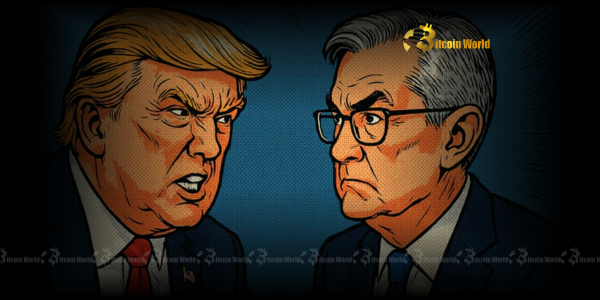Jerome Powell Resignation: Senator Lummis Unleashes Shockwave with Urgent Call
0
0

A seismic tremor has rippled through Washington D.C., and its potential aftershocks could be felt across the global financial landscape, including the volatile cryptocurrency markets. U.S. Senator Cynthia Lummis, a prominent voice for fiscal conservatism and a known advocate for digital assets, has made a stunning and direct demand: for Federal Reserve Chair Jerome Powell to step down. This isn’t just political rhetoric; it’s a serious accusation from a sitting senator, amplified by Watcher Guru on X, that Powell is “unfit to run the Fed.” This bold declaration raises critical questions about the future of monetary policy, the fight against inflation, and what it all means for your investments, especially in the digital asset space.
The Unprecedented Call: Why is Senator Lummis Demanding Jerome Powell’s Resignation?
Senator Lummis’s call for Jerome Powell’s resignation isn’t a casual remark; it’s a profound statement rooted in her assessment of the current economic climate and the Fed’s handling of it. While the specific reasons cited by Lummis in the Watcher Guru report were succinct (“unfit to run the Fed”), her broader public statements and policy positions offer more context. Lummis has consistently voiced deep concerns over the Federal Reserve’s response to surging inflation, arguing that the central bank was too slow to react, leading to significant erosion of purchasing power for American families and businesses.
Her criticism often centers on the perception that the Fed, under Powell’s leadership, allowed inflation to become entrenched by maintaining ultra-low interest rates and engaging in aggressive quantitative easing for too long. When the Fed finally began hiking rates, Lummis and others argued it was a belated and overly aggressive move that risked tipping the economy into recession. This delicate balancing act – controlling inflation without stifling economic growth – is at the heart of the debate. For Senator Lummis, the balance has been mismanaged, leading her to believe that a change in leadership is necessary to restore confidence and steer the nation’s economy more effectively.
The sentiment from Senator Lummis reflects a growing frustration among some policymakers and the public regarding the Fed’s performance. The post-pandemic economic boom, coupled with supply chain disruptions and geopolitical events, created a perfect storm for inflation. While the Fed initially characterized inflation as “transitory,” it proved to be far more persistent, leading to a scramble to tighten monetary policy. This shift, from a dovish stance to an aggressive hawkish one, has drawn both praise for its decisiveness and sharp criticism for its perceived delay and potential overcorrection.
Understanding the Federal Reserve’s Crucial Role and Federal Reserve Policy Impact
To fully grasp the weight of Senator Lummis’s demand, it’s essential to understand the immense power and responsibility vested in the Federal Reserve. As the central bank of the United States, the Fed has a dual mandate: to achieve maximum employment and maintain price stability. These two goals, while seemingly straightforward, often present complex trade-offs, especially in dynamic economic environments. The tools at its disposal include setting the federal funds rate, conducting open market operations (like quantitative easing or tightening), and regulating banks.
The impact of Federal Reserve policy impact on daily life is profound. When the Fed raises interest rates, borrowing becomes more expensive, cooling down economic activity and theoretically taming inflation. Conversely, lowering rates encourages borrowing and spending, stimulating growth. These decisions ripple through every sector, affecting mortgage rates, business investments, consumer loans, and even the valuation of assets like stocks and cryptocurrencies.
Under Jerome Powell, the Fed navigated unprecedented economic challenges, including the COVID-19 pandemic and its subsequent recovery. His tenure has been marked by:
- Aggressive Stimulus: Initially, the Fed implemented massive stimulus measures to prevent a deeper economic collapse during the pandemic, including near-zero interest rates and large-scale asset purchases.
- Inflation Surge: Following the stimulus, inflation surged to multi-decade highs, prompting a significant shift in monetary policy.
- Rapid Rate Hikes: The Fed embarked on one of the fastest rate-hiking cycles in decades to combat inflation, raising the federal funds rate from near zero to over 5%.
- Balance Sheet Reduction: Alongside rate hikes, the Fed began quantitative tightening, allowing its massive balance sheet to shrink, further removing liquidity from the financial system.
These actions, while aimed at achieving the Fed’s mandate, have not been without controversy. Critics like Senator Lummis argue that the initial stimulus was excessive, leading directly to the inflation problem, and that the subsequent tightening was either too late or too severe, risking a recession.
Navigating the Storm: How Do US Inflation Concerns Drive Political Scrutiny?
The rising cost of living has become a dominant issue for American households, and these US inflation concerns are a major catalyst for political scrutiny directed at the Federal Reserve. When prices for everyday goods and services—from groceries and gasoline to housing and healthcare—rise significantly, it directly impacts the financial well-being of millions. This tangible pain point translates into immense political pressure on elected officials, who in turn look for accountability from institutions like the Fed.
Consider the following impacts of persistent inflation:
| Economic Impact | Description |
|---|---|
| Reduced Purchasing Power | Each dollar buys less, eroding savings and real wages. |
| Uncertainty for Businesses | Difficulty in planning future investments and pricing strategies. |
| Increased Cost of Borrowing | Higher interest rates make loans more expensive for consumers and businesses. |
| Social Discontent | Frustration among the public over stagnant wages and rising costs. |
It’s within this context that calls for leadership changes, such as Senator Lummis’s demand for Jerome Powell’s resignation, gain traction. Lawmakers, responding to their constituents’ struggles, often question whether the Fed is acting swiftly and effectively enough to bring inflation back down to its 2% target. The debate isn’t just about economic theory; it’s about the lived experiences of ordinary Americans and the perceived competence of those in charge of the nation’s economic levers.
While the Fed is designed to operate independently of political influence to make objective decisions, its actions inherently have political consequences. When inflation runs hot, the Fed becomes a natural target for criticism, regardless of the underlying causes, which can include global supply chain issues, geopolitical conflicts, or fiscal policy. This dynamic ensures that Fed leadership will always be under intense public and political scrutiny, especially during periods of economic turbulence.
What Does This Mean for Crypto Market Stability?
The intersection of traditional monetary policy and the burgeoning digital asset space is a crucial one, and any significant shake-up at the Federal Reserve, such as a potential change in leadership, could have notable implications for crypto market stability. Cryptocurrencies, while often seen as an alternative to traditional finance, are not entirely insulated from macroeconomic forces driven by central banks.
Here’s how Fed policy and leadership changes can influence the crypto market:
- Interest Rates and Liquidity: Higher interest rates, a direct result of Fed tightening, tend to make riskier assets like cryptocurrencies less attractive. As the cost of borrowing increases, investors may pull capital from speculative assets to less volatile, yield-bearing traditional investments. Conversely, a more dovish Fed (lower rates, more liquidity) generally bodes well for crypto, as capital seeks higher returns.
- Investor Sentiment: Uncertainty at the Fed or about the direction of monetary policy can lead to increased volatility across all markets, including crypto. Investors prefer clarity, and a potential change in Fed leadership, particularly under contentious circumstances, would introduce a period of significant uncertainty.
- Inflation Hedge Narrative: For some, Bitcoin and other cryptocurrencies are viewed as a hedge against inflation and currency debasement. If the market perceives that a new Fed chair or a change in policy is more likely to lead to uncontrolled inflation, this narrative could strengthen, potentially boosting crypto prices. Conversely, if a new leader is seen as highly effective in taming inflation, the “inflation hedge” argument might weaken.
- Regulatory Outlook: While not directly tied to monetary policy, the broader economic philosophy of a new Fed chair could indirectly influence the regulatory environment for digital assets. A leader more open to innovation or, conversely, more inclined towards strict oversight, could shape future discussions around crypto regulation.
The current economic environment, with high inflation and aggressive rate hikes, has undeniably put pressure on the crypto market, contributing to the “crypto winter” experienced recently. A call for Jerome Powell’s resignation, therefore, is not just a political headline; it’s a potential signal of future shifts in monetary policy that crypto investors need to monitor closely. Any pivot in the Fed’s strategy, whether it’s a continuation of tightening or a shift towards easing, will likely send ripples through Bitcoin, Ethereum, and the broader altcoin ecosystem.
The Road Ahead: What’s Next for the Fed and the US Economy?
The call from Senator Lummis Fed Criticism highlights the intense pressure on the Federal Reserve as it navigates complex economic currents. While a senator’s call for resignation is significant, it’s important to remember that the Fed Chair is appointed by the President and confirmed by the Senate, serving a four-year term. A resignation would typically occur under extreme pressure or personal choice, and such public demands, while impactful, do not automatically trigger a change in leadership.
However, the ongoing scrutiny means that every decision made by the Federal Reserve will be met with heightened anticipation and analysis. The path forward involves several key considerations:
- Inflation Trajectory: The primary focus will remain on whether inflation continues its downward trend towards the Fed’s 2% target. Economic data, particularly the Consumer Price Index (CPI) and Personal Consumption Expenditures (PCE) index, will be critical.
- Interest Rate Decisions: Will the Fed continue to hold rates steady, or are further hikes or cuts on the horizon? This will depend heavily on inflation data and labor market conditions.
- Economic Growth: The Fed aims for a “soft landing” – bringing down inflation without causing a severe recession. The balance between fighting inflation and sustaining economic growth will be delicate.
- Political Landscape: As the 2024 election cycle heats up, the Fed’s actions will inevitably become a political talking point, adding another layer of complexity to its decision-making process.
The current climate demands astute leadership at the Federal Reserve. Whether Jerome Powell remains at the helm or not, the challenges of managing inflation, maintaining employment, and ensuring financial stability will persist. The economic narrative is continuously evolving, and the decisions made in the coming months will shape the financial futures of millions, influencing everything from the cost of your mortgage to the volatility of your crypto portfolio.
Conclusion: A Pivotal Moment for Monetary Policy and Markets
Senator Cynthia Lummis’s unequivocal call for Jerome Powell’s resignation underscores a moment of intense scrutiny for the Federal Reserve and its leadership. Her criticism, rooted in deep US inflation concerns and a perceived mismanagement of Federal Reserve policy impact, reflects a broader public and political frustration with the rising cost of living. While the immediate outcome of such a call remains uncertain, it highlights the immense pressure on the Fed to navigate a complex economic landscape. For investors, particularly those in the digital asset space, understanding these dynamics is paramount. The stability of the crypto market stability is inextricably linked to the broader macroeconomic environment shaped by central bank actions. As the debate over monetary policy continues, vigilance and informed decision-making will be key to navigating the opportunities and challenges ahead.
To learn more about the latest crypto market trends, explore our article on key developments shaping US economic outlook and monetary policy‘s influence on Bitcoin price action.
0
0
 Manage all your crypto, NFT and DeFi from one place
Manage all your crypto, NFT and DeFi from one placeSecurely connect the portfolio you’re using to start.





